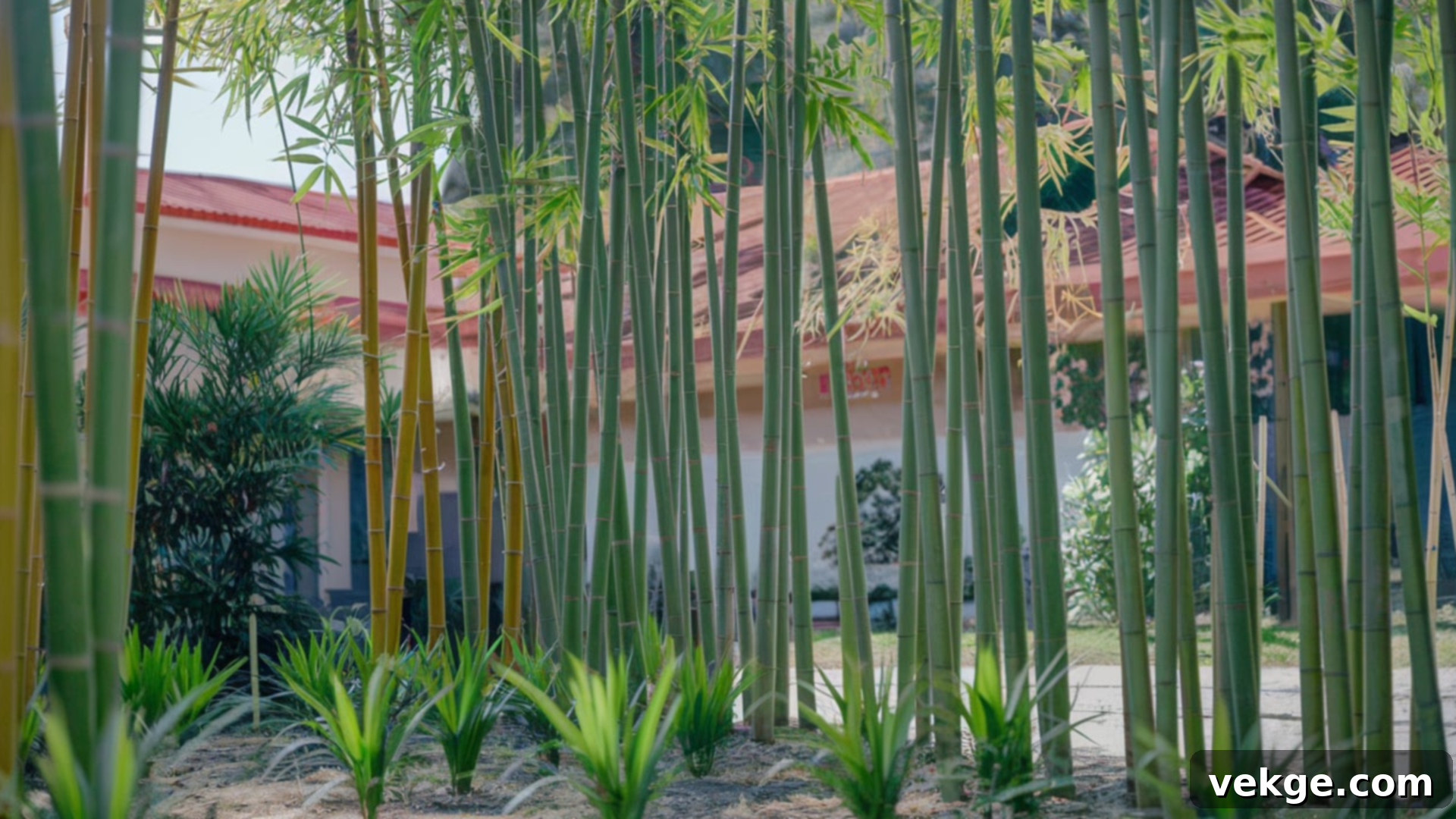How Long Does It Take for Bamboo to Grow? Unlocking Rapid Growth & Optimal Care
Few plants capture the imagination quite like bamboo, renowned worldwide for its incredible growth speed. Whether you’re envisioning a lush, green privacy screen, a serene garden grove, or simply curious about this botanical marvel, understanding its growth timeline is key. The common perception of bamboo shooting up overnight isn’t entirely a myth, but the full story of its development, from a delicate shoot to a towering, mature culm, involves several fascinating stages influenced by species, environment, and dedicated care.
In this comprehensive guide, we’ll delve deep into the question: “How long does it take for bamboo to grow?” You’ll discover the typical growth timeline from initial planting to full maturity, explore the diverse growth rates of popular bamboo species, and learn the essential factors that either accelerate or impede its development. From the fastest-growing giants to manageable clumping varieties perfect for containers, we’ll equip you with the knowledge to cultivate thriving bamboo in almost any setting.
Whether your goal is to create a living fence for immediate privacy, add an exotic touch to your landscape, or embark on a rewarding gardening project, the insights here will guide you toward achieving spectacular results. Curious about which type of bamboo grows the fastest, how to successfully grow it in a small yard, or even nurture it indoors? We’ve got all your questions covered. Let’s dig in and uncover everything you need to know about the remarkable growth journey of bamboo.
Understanding Bamboo’s Growth Timeline: From Shoot to Sturdy Culm
Bamboo’s reputation as one of the world’s fastest-growing plants is well-deserved, but its journey to full maturity is a multi-year process. While a bamboo shoot can indeed reach its ultimate height in a single growing season, the plant as a whole typically takes 3 to 5 years to establish a robust root system and produce thick, sturdy culms characteristic of a mature grove. Let’s break down this intriguing timeline:
- Initial Planting and Root Establishment (Months 1-12):
After planting, bamboo primarily focuses its energy underground. This initial phase is crucial as the plant establishes a strong network of rhizomes – the underground stems that spread horizontally, forming the foundation for future growth. You might see some initial shoots, but the bulk of the activity is hidden beneath the soil, building a resilient root system that will fuel impressive growth in subsequent years. This foundational work ensures the plant can draw ample nutrients and water for its rapid above-ground development.
- First Few Months to First Year: Emergence of New Shoots and Rapid Height Gain:
Once the root system is sufficiently established, typically within the first year of planting, new shoots (known as culms) will emerge from the ground. This is where bamboo truly lives up to its “fast-growing” reputation. Under optimal conditions, these new shoots can grow at astonishing rates, sometimes exceeding 3 feet (approximately 1 meter) per day! It’s important to remember that each individual culm reaches its full height and diameter within a single growing season. It will not grow taller or wider in subsequent years, but rather harden and mature.
- Years 1-3: Sturdier Culms and Grove Densification:
In the second and third years, the bamboo plant continues to expand its rhizome network and produce more numerous and often thicker culms each season. While individual culms still reach their full height quickly, the entire grove begins to densify and strengthen. The culms that emerged in the first year will mature, becoming harder and more resilient. The plant is essentially “filling out” and building its overall biomass, making it more robust and visually impactful.
- Years 3-5: Reaching Full Maturity and Optimal Vigor:
By the third to fifth year, most bamboo species reach what is considered full maturity. At this stage, the plant has a well-developed root system and produces a consistent flush of new, large, and vigorous culms each growing season. These culms will be representative of the species’ mature size and diameter. While new shoots will continue to emerge annually, the overall height and general structure of the established plant will remain relatively consistent, barring environmental changes or specific pruning. This is when your bamboo truly becomes a magnificent, self-sustaining feature in your landscape.
Key Factors That Influence Bamboo Growth Rate
While bamboo is inherently fast-growing, its actual growth rate and overall health are profoundly affected by a combination of genetic and environmental factors. Understanding these elements is crucial for anyone looking to maximize their bamboo’s potential and achieve their desired landscaping goals.
Species Differences: Running vs. Clumping Bamboo
The fundamental distinction between running and clumping bamboo is arguably the most critical factor influencing its growth and spread. Your choice here will dictate not only how quickly it grows but also how much maintenance it will require.
- Running Bamboo (Leptomorph): These species are known for their aggressive, fast-spreading nature. They send out long, vigorous underground rhizomes that can travel many feet from the parent plant before sending up new shoots. This characteristic allows running bamboo to cover large areas quickly, making it excellent for rapid establishment of privacy screens or naturalized groves. However, their invasive tendencies mean they require careful management, such as root barriers or regular rhizome pruning, to prevent them from spreading into unwanted areas. Examples include Moso Bamboo (Phyllostachys edulis) and Golden Bamboo (Phyllostachys aurea).
- Clumping Bamboo (Pachymorph): In contrast, clumping bamboo grows much more slowly and predictably. Its rhizomes are shorter and grow in a tight, U-shaped formation, causing new culms to emerge very close to the parent plant. This results in a dense, contained clump that expands gradually over time, typically only a few inches per year. Clumping bamboos are ideal for smaller gardens, containers, or situations where spread needs to be strictly limited, as they are non-invasive. Examples include Fargesia species (like Fargesia robusta or Fargesia murielae) and Bambusa species.
Essential Growing Conditions for Optimal Bamboo Vigor
Beyond species choice, the environment plays a pivotal role. Providing ideal conditions will significantly boost your bamboo’s growth rate and overall health.
- Sunlight Exposure: Bamboo generally thrives in full sun, meaning at least 6-8 hours of direct sunlight per day. Adequate sunlight fuels photosynthesis, providing the energy necessary for rapid growth. While many species can tolerate partial shade (4-6 hours of sun), they will typically grow slower and may not reach their maximum potential height or culm diameter. Some very sensitive species, especially in extremely hot climates, might benefit from afternoon shade to prevent leaf scorch, but bright, indirect light is usually a minimum requirement for vigorous growth.
- Water Requirements: Bamboo is a thirsty plant, especially during its active growing season and when establishing. Consistent and abundant watering is crucial for rapid growth. The soil should be kept moist, but not waterlogged. Inadequate water will slow growth dramatically, cause leaves to curl, and can even lead to culm dieback. Newly planted bamboo, as well as potted bamboo, will require more frequent watering than established in-ground plants. Good drainage is equally important to prevent root rot.
- Soil Quality and Nutrition: Well-draining, fertile soil rich in organic matter is ideal for bamboo. A slightly acidic to neutral pH (around 6.0-7.0) is generally preferred. Heavy clay soils that retain too much water can lead to root problems, while sandy soils that drain too quickly may not hold enough moisture or nutrients. Amending poor soil with compost, well-rotted manure, or other organic materials will significantly improve its structure, fertility, and water retention, providing the perfect environment for rhizome and culm development.
- Temperature and Hardiness: Most bamboo species are tropical or subtropical in origin and thrive in mild to warm temperatures. Consistent warmth encourages rapid metabolic processes and vigorous growth. While many temperate running and clumping species can tolerate significant cold, extreme freezing temperatures can damage culms and rhizomes, slowing growth. Knowing your USDA plant hardiness zone and selecting a species appropriate for your local climate is critical for long-term success.
- Nutrient Availability and Fertilization: Like all fast-growing plants, bamboo is a heavy feeder. It requires a steady supply of nutrients, particularly nitrogen for lush foliage and strong culm development. A balanced, slow-release fertilizer or one high in nitrogen (e.g., 3-1-2 or 2-1-1 ratio) applied in early spring and mid-summer can significantly boost growth. Organic fertilizers like compost, seaweed emulsion, or alfalfa meal also work wonderfully, improving soil health while providing essential nutrients. Avoid over-fertilizing, which can burn roots.
Location and Climate Specifics
The broader geographical context of your garden also plays a vital role. Tropical bamboo species will flourish in warm, humid climates with ample rainfall, mimicking their native habitats. Temperate species, on the other hand, are better adapted to areas with distinct seasons, including colder winters, but may still exhibit slower growth during colder months. Factors such as local rainfall patterns, soil composition unique to your region, and prevailing temperatures will all impact how quickly and successfully your chosen bamboo species grows and establishes itself. Understanding these regional nuances allows for better species selection and tailored care strategies, ensuring your bamboo thrives.
Popular Bamboo Species and Their Growth Characteristics
The world of bamboo is incredibly diverse, with thousands of species offering unique characteristics in terms of size, color, texture, and — crucially — growth rate. Here, we highlight some of the most popular species and their specific growth timelines.
1. Moso Bamboo (Phyllostachys edulis)
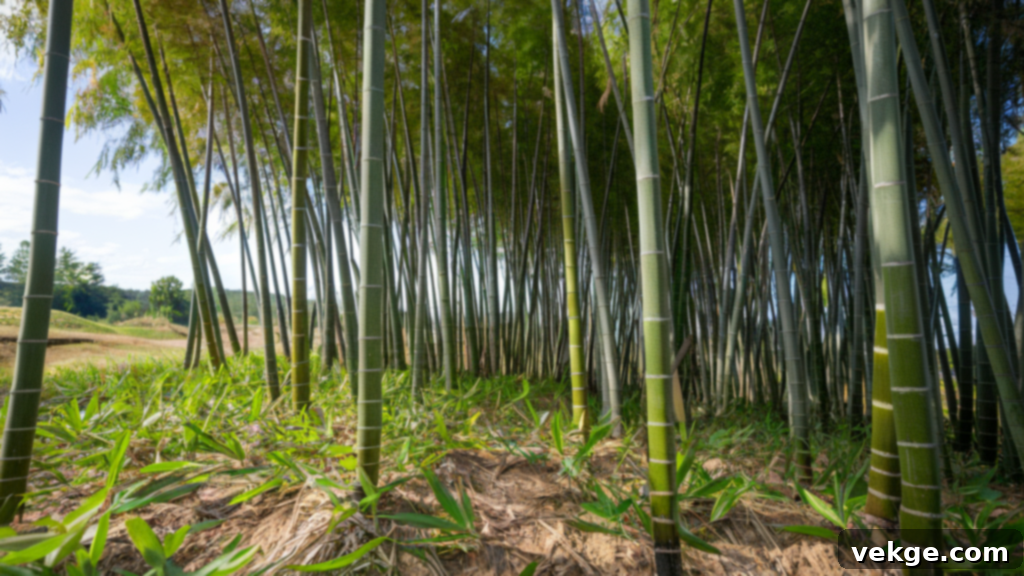
Often considered the most commercially important bamboo, Moso is a giant running bamboo known for its impressive culm diameter and rapid vertical growth. It’s highly valued for its strength, making it a primary source for timber, flooring, textiles, and even edible shoots. Moso thrives in warm, temperate climates (USDA Zones 7-10) with full sun and consistently moist, well-draining, fertile soil. Its majestic presence and fast establishment make it a popular choice for large-scale landscaping or creating dramatic, tall privacy screens.
- Growth Rate: Extremely fast, with individual shoots capable of growing up to 3 feet (about 1 meter) per day under ideal conditions during peak season.
- Mature Height: Can reach 50-70 feet (15-21 meters) or more, with culms up to 6 inches (15 cm) in diameter.
- Timeline to Full Maturity: Typically establishes a robust grove and begins producing large, mature culms within 5-7 years.
2. Giant Bamboo (Dendrocalamus giganteus)

As its name suggests, Giant Bamboo is a colossal clumping species, making it one of the largest bamboos in the world. Native to Southeast Asia, it thrives in tropical and subtropical climates (USDA Zones 9-11) where it can receive abundant rainfall and humidity. Its massive culms and dense foliage create an unparalleled, natural screen or a stunning focal point in large landscapes. Despite its size, being a clumping variety, its spread is easily managed, expanding slowly in a tight clump.
- Growth Rate: Very fast, with new culms growing up to 1 meter (3.3 feet) per day during peak season once established.
- Mature Height: Can reach astounding heights of 80-100 feet (24-30 meters) with culms over 12 inches (30 cm) in diameter.
- Timeline to Full Maturity: A well-cared-for plant can achieve significant size and density within 5-7 years, with mature culms emerging around the 5-year mark.
3. Black Bamboo (Phyllostachys nigra)
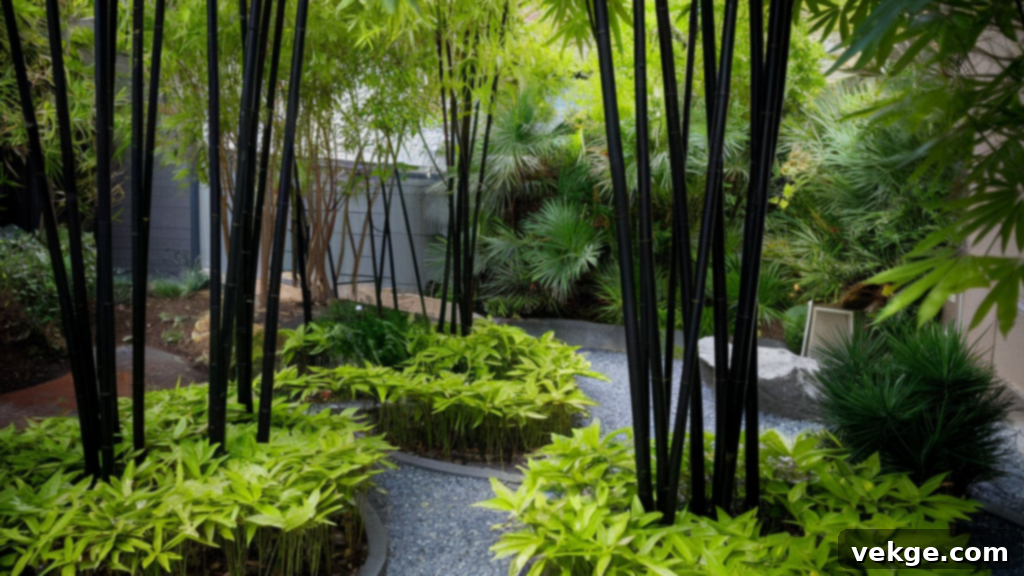
Black Bamboo is a highly ornamental running bamboo celebrated for its distinctive culms that mature from green to a glossy black over one to three years. This striking visual appeal makes it a favorite for decorative landscaping, adding an elegant and exotic touch to gardens (USDA Zones 7-10). It prefers full sun to partial shade and moist, well-draining soil. While it is a running bamboo, its growth rate is considered moderate compared to some of the more aggressive species, making it somewhat easier to manage its spread with appropriate barriers.
- Growth Rate: Moderate, typically growing new culms 2-3 feet (60-90 cm) in height per year, with the culms thickening over time.
- Mature Height: Reaches an average height of 15-30 feet (4.5-9 meters), with culms up to 2 inches (5 cm) in diameter.
- Timeline to Full Maturity: It generally takes 3-4 years for a Black Bamboo plant to establish and begin producing the characteristic black culms consistently.
4. Golden Bamboo (Phyllostachys aurea)
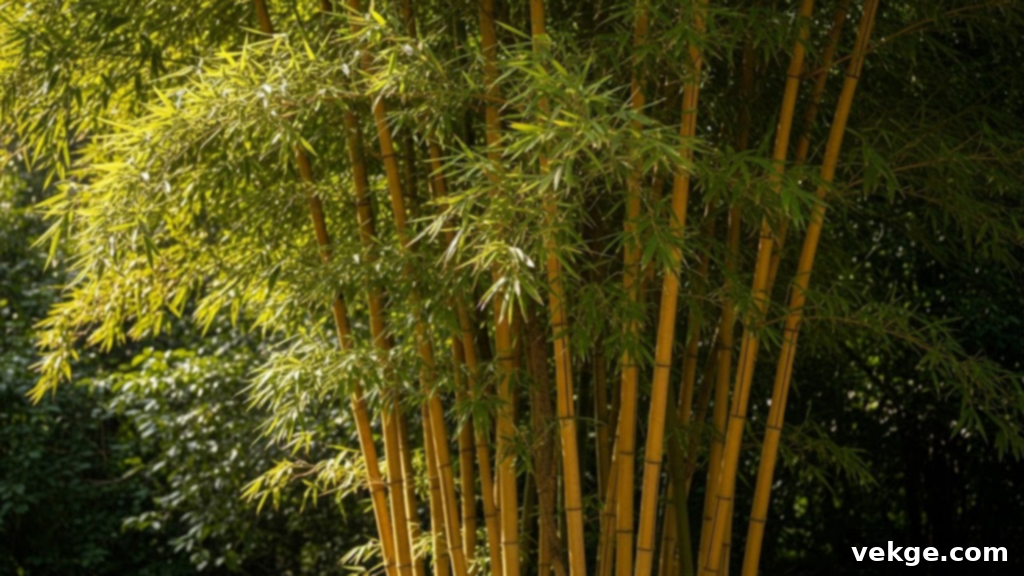
Golden Bamboo is an extremely vigorous running bamboo, highly popular for its rapid growth and distinctive golden-yellow culms that become more pronounced with sun exposure. It’s often used for creating quick privacy screens, hedges, or windbreaks due to its dense growth habit. Adaptable and relatively cold-hardy (USDA Zones 6-10), it tolerates a range of conditions from full sun to partial shade, making it a versatile choice for many gardens. However, its aggressive running nature demands diligent containment.
- Growth Rate: Very fast, new shoots can grow 6-12 inches (15-30 cm) per day during peak season. It spreads quickly via rhizomes.
- Mature Height: Typically reaches 20-30 feet (6-9 meters), with culms up to 2 inches (5 cm) in diameter.
- Timeline to Full Maturity: Can form a dense screen and reach significant height within 3-4 years.
5. Japanese Timber Bamboo (Phyllostachys bambusoides)
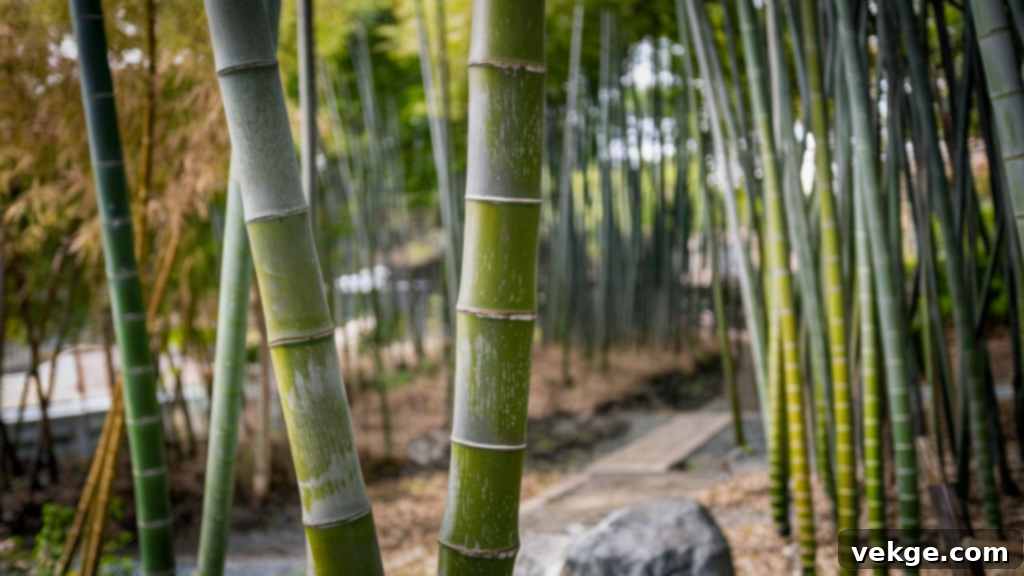
Also known as “Madake,” Japanese Timber Bamboo is another substantial running bamboo species, prized for its exceptionally straight, strong, and large culms that are ideal for construction, furniture making, and traditional crafts. It possesses an elegant, upright growth habit and tolerates a wide range of conditions (USDA Zones 6-10), including some colder temperatures once established. While not as explosively fast in height gain as Moso in its early years, it steadily produces impressive, durable culms.
- Growth Rate: Moderate to fast, but focused on developing strong, thick culms over sheer speed. New shoots appear reliably each season.
- Mature Height: Can reach 40-50 feet (12-15 meters) with culms up to 4 inches (10 cm) in diameter.
- Timeline to Full Maturity: Requires 5-7 years to fully establish and produce its characteristic large, thick, and durable timber-grade culms.
6. Fargesia Species (Clumping, Cold-Hardy)
While not in the original list, Fargesia bamboo is a critical mention for its popularity as a non-invasive, cold-hardy option. These clumping bamboos are native to high-altitude regions of China and thrive in cooler climates (USDA Zones 5-9), making them perfect for northern gardeners who want bamboo without the aggressive spread. Fargesia species are characterized by their graceful, delicate foliage and compact growth habit, making them excellent for hedges, specimen plants, or containers. They generally prefer partial shade, especially in hotter climates.
- Growth Rate: Moderate, expanding slowly over time. New culms emerge close to the parent plant.
- Mature Height: Varies significantly by species, generally 8-20 feet (2.5-6 meters).
- Timeline to Full Maturity: Typically forms a dense, mature clump within 3-5 years.
Growing Bamboo in Diverse Environments: Tailoring Your Approach
Bamboo’s adaptability allows it to thrive in various settings, but each unique environment presents its own set of challenges and opportunities. Understanding how to cater to bamboo’s specific needs in different situations is key to successful cultivation.
Growing Bamboo in Pots and Containers
Cultivating bamboo in pots or containers is an excellent solution for limiting the spread of running varieties or for those with limited garden space. However, this method requires diligent care to ensure the plant remains healthy and vigorous.
- Challenges: The most significant challenge is the restricted root space, which can quickly lead to the bamboo becoming “root-bound.” This condition stunts growth, reduces nutrient uptake, and can eventually kill the plant. Potted bamboo also dries out much faster than in-ground bamboo and is more susceptible to temperature fluctuations.
- Growth Rate: While still capable of rapid shoot growth, potted bamboo generally grows slower and to a smaller mature size than its in-ground counterparts due to root confinement and nutrient limitations. Fast-growing species like Golden Bamboo or Black Bamboo can still perform well, but their vigor will be somewhat constrained.
- Care Tips for Potted Bamboo:
- Choose the Right Pot: Select a large, heavy-duty container (e.g., glazed ceramic, fiberglass, whiskey barrel) with excellent drainage holes. The larger the pot, the longer your bamboo will thrive before needing intervention. Wider pots are generally better than merely deep ones for bamboo’s spreading rhizomes.
- Quality Potting Mix: Use a rich, well-draining potting mix that retains moisture but doesn’t become waterlogged. A mix for trees and shrubs, or a custom blend with compost and perlite, works well.
- Consistent Watering: Potted bamboo needs frequent watering, often daily in hot, dry weather. Ensure the soil is consistently moist, but never soggy.
- Regular Fertilization: Nutrients are quickly depleted in pots. Fertilize regularly during the growing season with a slow-release bamboo fertilizer or a balanced liquid feed.
- Repotting and Root Pruning: Every 2-3 years, you’ll likely need to repot your bamboo into a larger container or root-prune it. To root-prune, remove the plant from its pot, saw off about 1/3 of the outer root mass, and replant with fresh soil. This rejuvenates the plant and prevents it from becoming pot-bound.
- Winter Protection: In colder climates, potted bamboo is more vulnerable to freezing. Move pots to a sheltered location, wrap them, or bring them into a garage or unheated shed.
Cultivating Bamboo Indoors
While “Lucky Bamboo” (which isn’t true bamboo but a Dracaena species) is famously an indoor plant, growing genuine outdoor bamboo species indoors presents its own set of challenges. Most true bamboos are not ideal house plants, but smaller clumping varieties can be successfully grown with the right conditions.
- Challenges: Indoor environments often lack sufficient light, consistent humidity, and adequate air circulation that bamboo thrives on outdoors. Pests like spider mites can also be a more prevalent issue indoors. Growth will be significantly slower and smaller than outdoor cultivation.
- Growth Rate: Significantly slower than outdoor bamboo due to reduced light intensity and often less-than-ideal environmental conditions. It will not reach its mature outdoor size.
- Care Tips for Indoor Bamboo:
- Indirect Bright Light: Place your indoor bamboo near a bright window that receives plenty of indirect sunlight. Direct, harsh sun through glass can scorch leaves. Supplement with grow lights if natural light is insufficient.
- Maintain Humidity: Bamboo appreciates humidity. Mist the foliage regularly, place the pot on a pebble tray filled with water, or use a room humidifier.
- Consistent Watering: Keep the soil consistently moist, but ensure excellent drainage to prevent root rot.
- Good Air Circulation: Ensure the plant has good airflow to prevent fungal issues.
- Pest Monitoring: Regularly inspect for common indoor pests like spider mites, scale, or mealybugs. Treat promptly with insecticidal soap or neem oil.
- Species Choice: Opt for smaller clumping species like certain Fargesia varieties or smaller Bambusa species, which are more amenable to container life and less aggressive.
Growing Bamboo in Small Spaces or Cold Climates
These two scenarios, while different, often share similar needs for careful species selection and protective measures.
- Challenges: In cold climates, the primary challenge is survival through freezing temperatures and desiccating winter winds. In small spaces, the main concern is managing the bamboo’s natural tendency to spread, especially for running varieties.
- Growth Rate: Growth will be slower in colder climates as the plant expends energy on survival rather than rapid expansion. In small spaces, growth might be restricted by root barriers or pot size, influencing overall vigor.
- Care Tips for Small Spaces and Cold Environments:
- Choose Cold-Hardy Species: For cold climates (USDA Zones 5-7), Fargesia species (e.g., Fargesia rufa, Fargesia murielae, Fargesia nitida) are highly recommended. They are clumping and can tolerate temperatures down to -20°F (-29°C) or even lower, though culm dieback may occur in extreme cold.
- Clumping Varieties for Small Spaces: Always opt for clumping bamboo in restricted areas to avoid invasive spread. If a running variety is desired, install a robust rhizome barrier (typically 24-30 inches deep) or plant in a heavy-duty container.
- Winter Protection (Cold Climates):
- Mulch: Apply a thick layer of organic mulch (wood chips, straw) around the base of the plant in fall to insulate rhizomes.
- Shelter: Plant in a sheltered location, away from harsh winter winds, or provide temporary windbreaks.
- Watering: Water deeply before the ground freezes to ensure rhizomes are hydrated.
- Container Plants: Bring potted bamboo into an unheated garage or shed, or heavily insulate the pot.
- Pruning for Small Spaces: Regular thinning of older culms and trimming of branches can help maintain a desired shape and size for bamboo in confined areas.
With careful planning and attentive care, bamboo’s versatility allows it to thrive and contribute beauty and function across a wide spectrum of environmental conditions.
Utilizing Bamboo for Specific Landscaping Purposes
Bamboo’s rapid growth and versatile nature make it an exceptional choice for various landscaping needs, from creating secluded havens to establishing sustainable resource groves.
Creating Effective Bamboo Privacy Screens and Hedges
One of the most popular uses for fast-growing bamboo is to establish a natural, dense privacy screen or hedge. With the right species and care, you can achieve remarkable results in a relatively short timeframe.
- Growth Timeline: A bamboo privacy screen can achieve significant height and density within 3 to 5 years, providing effective visual and often sound screening. The initial years are focused on establishment and spreading, with each subsequent year bringing thicker, taller culms that fill out the screen.
- Species Recommendations:
- For Fast, Tall Screens: Running species like Moso Bamboo (Phyllostachys edulis), Golden Bamboo (Phyllostachys aurea), or Japanese Timber Bamboo (Phyllostachys bambusoides) are excellent choices. They quickly grow tall and dense, but remember they must be contained with a robust rhizome barrier (at least 24-30 inches deep) to prevent unwanted spread into neighboring areas or other parts of your garden.
- For Contained, Dense Screens: Clumping varieties such as Fargesia robusta ‘Pingwu’ or Bambusa multiplex ‘Alphonse Karr’ (for warmer climates) are perfect. They grow into dense, non-invasive clumps, making them ideal for smaller yards or situations where spread is a concern. While their initial growth might be slightly slower than aggressive runners, their controlled habit makes them easier to manage in the long run.
- Care for Screens:
- Spacing: Plant bamboo closer together than you would for a grove to achieve a dense screen faster (e.g., 3-5 feet apart for running varieties, 2-4 feet for clumping, depending on mature size).
- Sunlight and Water: Ensure full sun (or partial shade for Fargesia) and consistent, ample watering, especially during establishment.
- Pruning: Regularly thin out older, weaker culms at ground level to encourage new, vigorous growth and maintain the screen’s density and health. You can also trim the top of culms to maintain a desired height, though the culms themselves won’t grow taller once cut.
Establishing Productive Bamboo Groves
For those with larger properties or an interest in sustainable resources, establishing a bamboo grove offers both aesthetic beauty and practical benefits, such as harvesting culms for various uses.
- Growth Timeline: A bamboo grove typically establishes within 3-5 years, with the first harvestable culms appearing. It reaches full maturity and sustainable productivity within 5-7 years, at which point you can begin annually harvesting mature culms without harming the grove’s long-term health.
- Species Recommendations:
- For Large-Scale Groves: Running bamboo species are best for establishing expansive groves quickly. Moso Bamboo and Japanese Timber Bamboo are top choices due to their large, strong culms suitable for construction and craft. Their natural spreading habit helps fill out the grove over time.
- For Smaller, Contained Groves: While clumping bamboo doesn’t form “groves” in the traditional spreading sense, dense plantings of species like Giant Bamboo (Dendrocalamus giganteus) in tropical zones, or robust Bambusa species, can create beautiful, contained forest-like areas without the need for rhizome barriers.
- Care for Groves:
- Initial Watering: Water consistently and deeply during the first few years to encourage strong rhizome development.
- Fertilization: Fertilize annually in spring to support robust new growth.
- Harvesting: Once mature (5-7 years), harvest culms that are at least 3 years old. This selective harvesting maintains the health and productivity of the grove. Never remove more than 20-30% of the culms in a year.
- Management: For running bamboo groves, regular mowing around the perimeter or using a rhizome barrier will prevent unwanted spread beyond the designated grove area.
By selecting the appropriate species and providing attentive care, bamboo can serve as a highly effective, beautiful, and sustainable solution for diverse landscaping purposes.
Essential Tips for Optimizing and Speeding Up Bamboo Growth
To ensure your bamboo thrives and reaches its full potential as quickly as possible, a proactive and consistent approach to care is essential. Here are key strategies to optimize its growth:
- Enhance Soil Quality: Bamboo performs best in rich, well-draining, and slightly acidic to neutral soil (pH 6.0-7.0). Amend heavy clay soils with organic matter like compost, aged manure, or coarse sand to improve drainage and aeration. For sandy soils, adding compost will increase water retention and nutrient availability. A healthy soil foundation is paramount for robust rhizome development.
- Master Watering Techniques: Consistent moisture is critical for rapid bamboo growth, especially during the establishment phase and hot, dry periods. Water deeply and regularly, ensuring the soil remains moist but never waterlogged. Overwatering can lead to root rot, while under-watering will stunt growth and cause leaf curl. Installing drip irrigation can provide steady moisture efficiently.
- Ensure Adequate Sunlight Exposure: Most bamboo species thrive in full sun (6-8+ hours daily). More sunlight generally equates to faster and more vigorous growth. If planting in a less sunny spot, choose a species known to tolerate partial shade (e.g., Fargesia varieties). Monitor for signs of stress (leaf yellowing or scorching) if your bamboo is in intense, unbuffered direct sun in very hot climates.
- Implement Regular Fertilization: As a heavy feeder, bamboo greatly benefits from regular fertilization. Apply a balanced, slow-release fertilizer high in nitrogen (e.g., a 3-1-2 ratio) in early spring as new shoots begin to emerge, and again in mid-summer. Organic options like compost tea, fish emulsion, or a granular organic fertilizer can also provide a steady supply of nutrients, enriching the soil food web.
- Strategic Pruning and Maintenance:
- Thinning: Annually remove older, damaged, or weak culms at ground level to encourage the plant to put energy into producing new, stronger culms. Thinning also improves air circulation, which is beneficial for plant health.
- Rhizome Control (for Running Bamboo): For running species, implement a physical rhizome barrier (24-30 inches deep) or regularly prune emergent rhizomes at the edge of your desired growing area. Without control, running bamboo can become invasive.
- Top Trimming: While individual culms don’t grow taller after reaching their maximum height in a season, you can top-trim culms to maintain a desired height for hedges or screens. This will encourage bushier growth lower down the culm.
- Choose the Right Species for Your Goals: The fastest way to achieve your desired outcome is to select a bamboo species that naturally aligns with your climate, available space, and specific purpose. For rapid height, consider Moso or Golden Bamboo (with containment). For a non-invasive screen in cooler climates, Fargesia is ideal. Researching species characteristics thoroughly before planting is paramount.
- Protect Against Pests and Diseases: Healthy bamboo is generally resistant, but occasionally pests like bamboo mites, scale, or aphids can appear. Inspect your plants regularly. Address issues promptly with appropriate organic solutions (e.g., insecticidal soap, neem oil) or by removing affected culms. Ensure good air circulation and avoid over-stressing the plant, as stressed plants are more susceptible.
By consistently applying these care strategies, you’ll not only witness your bamboo grow quickly but also develop into a strong, healthy, and stunning feature in your landscape for years to come.
Conclusion: Cultivating Your Thriving Bamboo Landscape
You now have a comprehensive understanding of how long it takes for bamboo to grow and, crucially, the multifaceted approach required to help it not just survive, but truly thrive. From the initial subterranean network of rhizomes to the explosive vertical growth of new culms and the eventual establishment of a mature, robust plant, bamboo’s journey is a testament to nature’s incredible efficiency.
Remember, while bamboo’s reputation for rapid growth is well-earned, achieving optimal results hinges on a few key pillars: selecting the right species for your specific climate and purpose, providing ideal growing conditions (sunlight, water, nutrient-rich soil), and committing to consistent care. Whether you’re aiming for a lush privacy screen in a few years, a sustainable grove, or an elegant container specimen, your patience and attention will be richly rewarded.
The insights shared here will empower you to make informed decisions, ensuring your bamboo investment flourishes. With the right setup and ongoing maintenance, your bamboo will grow strong, tall, and surprisingly fast, transforming your outdoor (or even indoor) space into a verdant sanctuary.
Eager for more expert tips to craft a low-maintenance, beautiful outdoor oasis? Dive into other gardening and landscaping guides on our website. They are packed with beginner-friendly ideas and advanced strategies you can start implementing today to cultivate the garden of your dreams.
